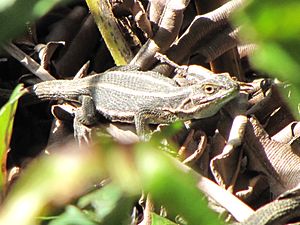Cyan tree iguana facts for kids
Quick facts for kids Cyan tree iguana |
|
|---|---|
 |
|
| Conservation status | |
| Scientific classification | |
| Genus: |
Liolaemus
|
| Species: |
cyanogaster
|
The Liolaemus cyanogaster, often called the cyan tree iguana, is a fascinating type of lizard. It's part of the Liolaemidae family, which is a large group of lizards found mostly in South America. This particular iguana is special because it is endemic to Chile. This means it lives naturally only in Chile and nowhere else in the world. You can find many of these lizards in Chile, especially in the area between the cities of Concepción and Puerto Montt.
Contents
About the Cyan Tree Iguana
The cyan tree iguana is a small to medium-sized lizard. Like all lizards, it is a reptile. This means it has scales and is a cold-blooded animal. Cold-blooded animals rely on their environment to control their body temperature. They often bask in the sun to warm up.
What Does It Look Like?
The name "cyan tree iguana" gives us a clue about its appearance. "Cyan" refers to a greenish-blue color. While the exact colors can vary, these lizards often have beautiful patterns. They might have shades of green, blue, or brown. These colors help them blend into their surroundings. This is called camouflage. It helps them hide from predators and sneak up on their prey.
Like other lizards, the cyan tree iguana has four legs and a long tail. Its tail helps it balance, especially when climbing trees or rocks. It also has sharp claws that are perfect for gripping surfaces.
Where Does It Live?
The cyan tree iguana lives in Chile. It is found in the central and southern parts of the country. This region includes the Valdivian temperate forests. These forests are known for their lush, green plant life and mild, rainy climate. The lizards often live in trees, as their name "tree iguana" suggests. They can also be found on rocks or on the ground. Their habitat provides plenty of places to hide and find food.
What Does It Eat?
Most lizards, including the cyan tree iguana, are insectivores. This means they mainly eat insects. They might hunt for beetles, spiders, ants, and other small creatures. They are active hunters, using their keen eyesight to spot prey. Their quick movements allow them to catch insects swiftly. Eating insects helps control insect populations in their ecosystem.
How Does It Live?
Cyan tree iguanas are generally active during the day. This makes them diurnal animals. They spend their days basking in the sun to get warm. Once warm, they search for food and interact with other lizards. They are often shy and will quickly hide if they feel threatened.
Like many lizards, they lay eggs. The female lizard will find a safe spot to lay her eggs. After a period, the baby lizards hatch from the eggs. They are usually small versions of the adults and must learn to survive on their own.
Protecting the Cyan Tree Iguana
The Liolaemus cyanogaster is currently listed as "Least Concern" by the IUCN. This means that, for now, it is not considered to be at high risk of extinction. However, it's always important to protect all species.
One of the biggest threats to many animals is habitat loss. This happens when their natural homes are destroyed or changed. Protecting the forests and natural areas where these iguanas live is very important. Conservation efforts help ensure that these unique lizards can continue to thrive in Chile for many years to come.
See also
 In Spanish: Lagartija valdiviana para niños
In Spanish: Lagartija valdiviana para niños


